Classmate / OLPC camp. Learning can be fun!

The media laboratory and the Open Source Linux Lab , which once prepared for you an article about the use of OLPC XO notebooks in the harsh conditions of the Russian camp , continue to broadcast from the village of Old Deserts, Nizhny Novgorod region. The computer camp was held from the 10th to the 20th of August and this time, in addition to children from four schools in Nizhny Novgorod, there were children of programmers who read about us in journal articles and blogs.
And this time, in addition to the OLPC XO, we have children's educational laptops from the titanium computer industry - Intel. So, Classmate PC, flowers of life and retraction of the brain!
A lot of pictures, be careful.
Again, we are writing about devices that it is difficult to get in Russia for free - and difficult to buy.
However, the target audience of these devices (often not reaching a wise coder to the navel, but constantly claiming the role of future pride, support and support) can get acquainted with it, if it strongly wants. In the article we will try to summarize the results of the second digital camp with an environmental bias “Computer Desert 2009”.
Devices
In short, this time applied
- OLPC XO-1,
- Classmate PC (1st generation) + camera,
- less interesting ASUS's,
- gps devices
- Picoboard
- meteostation,
- telescopes and microscopes.
Just did not have enough time to fully study the LEGO Mindstorms robot and the Nova 5000 laboratory. From software tools: wikis for recording activities, publishing an online newspaper, communicating with parents, and also as a version control system, Scratch as a programming language, plus small things MS Office (drawing graphs and charts for social issues).
First, a brief run through all the glands.
OLPC XO-1
')

I like to talk about him very much , because this machine 4 years ago (correct me, if not right) already had a list of features, to which the handsome Intel Classmate 3 is approaching just now, namely:
- Armor piercing, and the complete absence of moving parts
- water tightness
- carry handle and swivel screen
- camera, microphone, portico 3 usb
- $ 17 battery for 5 hours
- dual layer screen to work in the sun
- the ability to connect to a wireless standard network 802.11s, which means that without any access points (for example, in a forest or swamp)
- wide touchpad, rolling in a wide tablet
- wonder-window-manager Sugar inside
Classmate PC 1

What can I say - such a kind of netbook, not very thoroughbred and outwardly outstanding, perhaps, only a blue shirt to soften the blows. Still, the first model is weaker than the OLPC-shki will be - not that the third one. I don’t like to savor things like a rough plastic or a round touchpad, but the clothespins with battery-operated handles really caught my eye.
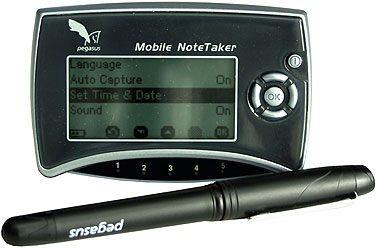
The device is called Note Taker (a good overview of this device). It works like this:
- we pin a piece of paper to the clothespin,
- turn on the NoteTaker program on the laptop,
- draw on paper and see how the image appears on the screen.
This is not some new invention of Intel, but the piece came in handy more than once or twice.
The operating system on the class mates was, alas, not Linux, but that one, the other;) And therefore, by the third day, the viruses that came from the flash drives of the guys ate two machines - they had to be reanimated.
Pieces with sensors
If you are a person with a technical mindset - be sure to try the touch devices. Programmed to recognize colors and warmth of LEGO-MindStorms, every adult robot can lead to ecstasy. As for young fifth grade programmers, this is the best platform for learning how to program as an interesting discipline.
Nova 5000
To make your own light musical instrument with the help of the Picoboard, to teach the robot to pull the girls by the skirts, and to give the guys the honor - all these things give young researchers invaluable motivation. For older people (8-9 class), you can offer mobile digital laboratories such as this Nova 5000.

Even the simplest temperature sensors can arouse interest in physical and environmental research. A live example: Suppose we measured the temperature values in the kettle and saw its graph. Starting from 96 degrees, the graph stops growing. Why is the boiling point of water not 100 degrees? Salt impurities? Pressure? But the starting set of sensors includes much more: the speed of the air flow, pressure, acidity. How does the pH level in swamp, river and lake water differ? How do his fluctuations depend on time?
Picboard

The next device called Picoboard is a board with sensors. On the board there are: a button, a lever, a light sensor, a microphone and two sensors for measuring voltage. And there would be no good from her if it were impossible to connect this board to the Scratch programming system. Oh, I will tell you a lot about Scratch, just wait a minute. In the meantime, for all a simple task: what does this program do?

LEGO Mindstorms robots
Recently, about the LEGO robots there is a small surge of activity ( one , two , three ). And this means that robotics in Russia will have to go through a boom!
The minimum starting set of sensors (sound, ultrasound, touch, light) was expanded with an infrared sensor, a light sensor and a compass from Hi-Technic . It does not interfere with the purchase of another gyroscopic angular velocity meter (probably called it all the same otherwise). With it, you can make and Seagway and a glove for virtual reality, and telekinesis wand.
Lego Mindstorms robots


If a bunch of Scratch + Picoboard allows you to move a piece of reality into the world of Scratch, then Lego Mindstorms is, on the contrary, the transfer of the virtual world of a child demiurge into the real world
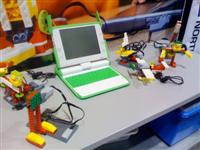
Both Picobord and Mindstorms robots can be easily and transparently connected to XO - so they will have to learn the amazing world of the modprobe team later.
And this is how the program for the robot looks like - Mindstorms have a visual programming language based on LabView (some recent students will recall the lessons of digital signal processing). Again, the building blocks of knowledge from which the program is composed.

GPS devices
The cub, which the camp explained how to navigate the terrain using a compass and GPS-navigator, will never serve as food for hyenas, scouring in the Nizhny Novgorod deserts. The following devices were used.
Two GPS mice model BU-353 - used in conjunction with classmate.

The two Garmin eTrex tourist navigators, the Vista models and the Venture HC, were given to the Neogeographers laboratory children so that they could lead the expedition on the right path.


Classes
This year we dug in depth. For 10 days, it was necessary to make the fifth graders of motivated programmers, community scientists and environmentalists spending time in constant campaigns and having completed work in their portfolio. Each laboratory focused on working on a single project. Software product, online newspaper, a series of multimedia articles with environmental research.
Programmers
What to write to the programmer? And what will any child ask you when you call him your profession? "Programmer? Do you write games? ”
Playing the game, but I wanted to show the guys that they are capable of working as tuning coders from reputable companies. I had to invent a development process for them and select tools. I was guided by such specificity:
- all the developers are young enough - 5 brave men and two beautiful maidens from the 5th grade of the secondary general education school who know nothing about programming at all
- terms are very limited - 10 days, 5-6 of which children spend on environmental expeditions,
- the project should be closely related to both ecology and programming
So, it was necessary to choose the degree of formality of the process and a set of tools.
What to write? Ode to one childish language

The implementation language did not cause any doubts - a great, powerful, non-learning OO-language Scratch . The source of inspiration is ecological hikes and expeditions, seen and studied beaver spiders, plants, lichens, horsetails and moss.
About the scratch need to tell separately. First of all, I have never read a single scratch book (by the way, there is one ).
Any programming language (in my opinion) is like a Go game. At the very beginning there is a bare board and stones in front of you - a text editor and keyboard. Using our knowledge, we add logic from English letters, enjoying pleasure from the process of creation. This pleasure compensates us for the terrible hours spent in a stubborn environment setting, learning manes, exams, and tutorials. The tighter the programmer is sitting on this needle, the more time he spends behind the code, the larger the specialist becomes. The development of a craving for deferred pleasure is one of the most important steps on the path of self-development.

What are they doing in so many schools instead? Computer science lessons are learning Word and Excel. And if you're lucky, work with Turbo Pascal: loops, branches, lists, and arrays. And the smart cub will ask, “What the hell are these lists for me? Where are they in real life? ” And this question will hang in the void.
Some were more lucky on computer science with tools - they were given a Logo bug or its numerous kengurenka, vacuum cleaner, Idol type clones. A hacker and a computer genius will be able to show everyone their algorithmic skills by drawing the most beautiful picture with a turtle. However, drawing and algorithms will end here.
Scratch also allows you to not only draw using one artist. There can be many artists, you can create and draw them yourself. Each performer (sprite) has its own:
- outfits
- sounds
- script that defines its behavior and interaction.
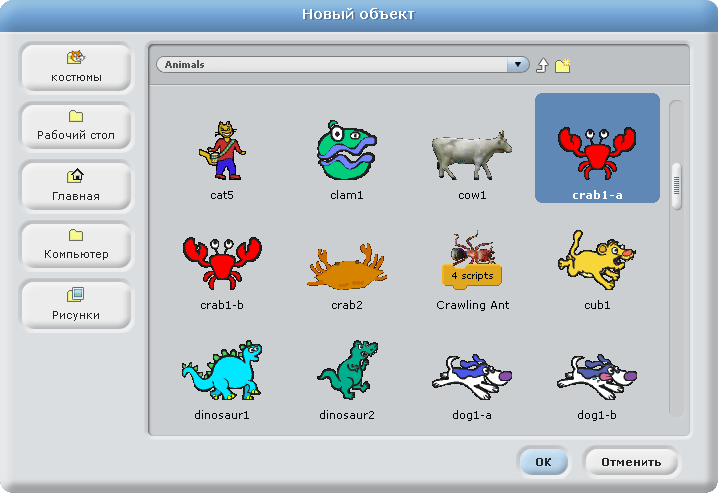
Scripts may include:
- character movements,
- managing the change of costumes (for example, in order for the hero to walk, you must move it along the x-axis and change costumes with different leg positions),
- making sounds
- sending signals to other characters - because the scratch's legs grow from Smalltalk - the very kosher OO language
Here is an example program:

And of course, in Scratch there are all possibilities for creating cycles, branching, the possibility of arithmetic and Boolean logic.
Communication & collaboration
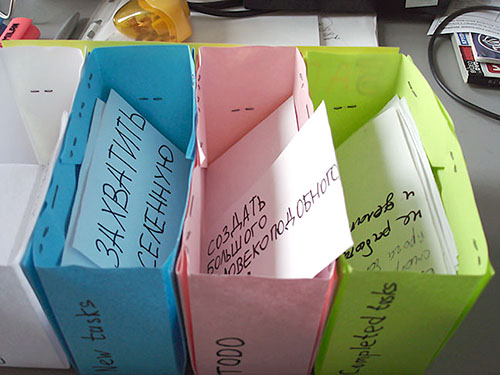
Wiki was teaching the markup right in the camp, which we took advantage of by starting a great project page. The version control system appeared somehow by itself. The guys quickly realized that transferring files through a flash drive was a disgraceful task and started putting their scratch projects on the wiki. At first they put them under different names, but then they noticed that if the same file (for example, Bukashka.sb) was put on the wiki two times, then both versions would be available in it - it would just be necessary to choose the desired one. So wiki replaced us with VCS.
Bugtracker Here, the experience of sitting behind the Habr came in handy. I just used the idea of a hardwood boot from here - the picture is from the same place. Thank you, Restorer ! For those who are too lazy to follow the link, I tell them - we have got three boxes with pieces of paper:
- task pool for tasks waiting for their heroes
- task box
- box for tasks that turned out to be not necessary
Development process
I remember the books on RUP'u and the artifact Roles. It was nice to be aware of yourself as a deployment manager ... a system architect ... and how nice and useful it would be to apply it here! So we have chosen the main programmer, development and testing group, design group.

Next, about the process. The language allowed the development of individual sprites autonomously; the main programmer got the task of integrating the modules of the program, converting absolute coordinates into relative ones, matching game backgrounds, and thinking through physics. He worked very much, but thanks to the introduction of the coding standard, it turned out to be a great relief for the boy.
The genre of the game is an arcade in the style of Mario. Programmers implemented the logic of the behavior of the protagonist, rzalichnye algorithms for the movement of its enemies. One even made an enemy associated with Picobord. Depending on the light and turns of the lever, this ultimate-enemy could move in a variety of ways and was the hardest to pass. Designers worked on the creation of backgrounds and skins for the characters in the game. Many enemies were taken from the fauna seen and photographed during the campaigns.
It was important to learn to perceive information from each other. The guys had the right to one question for senior managers. Who understood the answer to the question should have trained his colleagues.
After the Transition phase, RUP is supposed to conduct an analysis of the project. This is called a postmortem.
It discusses:
- successful solutions
- the need for artifacts,
- slips that do not need to be repeated further,
- group work evaluation,
- assumptions about what to do otherwise
- project perspectives
Autopsies help the developer to work precisely on his shortcomings and show his strengths - what could be more important?
The results of the opening of the project-game "Wanderer" you can see on the project wiki, when she joins Letopisiam.ru. And you can try to play the game and download the source code from the scratch site .
Neogeographers
I asked the leader of the Neogeographers to answer a couple of questions. Aleksey Kiselev reports:
Q: What are GPS used for?
A: There were several uses:
- Route maintenance. The GPS device writes the track of our movements on the routes and we post it on the site. In this way
we carry out documentation. This is necessary, for example, in order to mark them in time stamps on photographs with points in the terrain.
In addition, we get statistics on mileage, travel time, speed, etc. - Geotagging. Mark the coordinates of noteworthy objects. Each stop during an ecological route is correctly called a station. At the stations biological objects are studied and demonstrated. For good, each station of the route is marked with coordinates and, accordingly, time.
Geocaching Search for points by previously known coordinates. In our case, the game. In some cases, it was a search for previously noted coordinates of remarkable biological objects (for example, nests).
Cartography. Creating your own plans using GPS data and creating thematic layers with GPS data on Google maps and Ozi maps. This time they tried to create maps directly by means of Wiki itself. For this set the plugin
Q: Was there something new? With microscopes? With telescopes?
A: With Nova there was only a demonstration. The fact is that the set of sensors was not very relevant for the environmental expedition. For example, there was a number of sensors for measuring meteorological parameters, but for this we had a digital weather station WS-2310 , which did it perfectly.
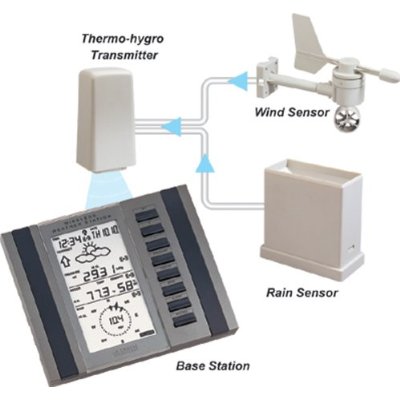
The sensors for working with electricity turned out to be unclaimed, the photo rotation for experiments on mechanics, too. For us, the concentration sensors of substances would be important, they are in the Nova catalog, but we do not have them yet. It was thought that we could measure the New values of humidity in biotopes, the temperature profiles of water and soil, the level of illumination.
We only had optical microscopes. A binocular microscope stood in the laboratory and the children looked into it at any time, as well as through a telescope standing on the veranda. Now we are thinking about devices like the Digital Blue QX5 - this is an electronic children's learning microscope with good support from the computer (a powerful graphic editor, the ability to record and edit video), but the question requires study.

Two more binoculars were always hung at hand and were for everyone. But what is valuable is that we were engaged in macro photography on digital cameras. A collection of butterflies and caterpillars with a resolution sufficient to see all the details of the structure of the bodies of insects.
There were two telescopes. One telescope system of the refractor on the horizontal mount - DeepSky. This device was used both for night observations and for observing distant objects during the day, and specifically birds. The second telescope of the reflector system on the equatorial mount is Mizar. It was used for night observations. There was an experience when we photographed the moon with a camera through the eyepiece of a telescope. And the meteor shower, which came just at the end of August, could be observed without a telescope.

Of the devices there were still a voice recorder, a video camera, although the video was also shot on a camera more. Actually a digital camera is such a thing, which was universally used instead of a microscope and instead of a telescope both as a dictaphone and a video camera.
Journalists
The laboratory of journalism, as you can guess, was managed by a journalist - deputy editor-in-chief of iToday . Little journalists recorded all the events, often doing it right in the campaigns, so they were given OLPC shnye notebooks. I am not in a position to tell a lot about their activities here, but I often heard very correct words with which fifth graders exchanged words. For example, “soon deadline”, “assign the task to the corrector” and so on.
I know that they have been set the norm on the number of articles per day. 3 news, and even you burst. Plus one publication in a different genre. Does anyone remember that the newspaper he bought at the store was empty? And all because such a rule is in every edition.
The genres with which the guys got acquainted - survey, interviews, news reviews. For surveys learned to draw diagrams.
The project of journalists is the online newspaper “Pustynnevnost”. The newspaper did not have a special campaign, but 50 percent of the children actually read it and almost all of their parents.
results

No matter how good the articles and programs we have created, the main results of the camp are not posted on the Internet, but rest and take root in the minds of the children, namely:
- mastering the concepts of programming - all algorithmic structures and some data structures (cycles, branches, variables, lists) were used by the guys in practice - while working on their game.
- mastering the technology - the most elementary is GPS. And the most severe owners of OLPC XO-nisk even managed to master a couple of commands in the console, when they played music on mplayer flash drives.
- representation of the work of the programmer, journalist and ecologist. Everything that happened in the laboratories was so strongly reminiscent of adult life that I even decided to prepare an article describing the development process of the “Wanderer” and clearly showing typical mistakes in building software by small groups of developers.
- perception of the computer as a tool for research and creativity, and not just as a playground for games.
- Socialization. An idea of teamwork.
- community building. It’s too early to talk about it yet, but the scratch team at postmortem decided to continue the project and then start developing a new game. At first, they need strong support from the side ( including motivational support - write us admiring letters!), But if this does not burn out - the camp can be considered completely successful.
After conclusions
Amazing 10 days of this camp is over. Training in it was conducted with a mad intensity and was combined with a fundamentally new for the school - a design method of training. How to measure the benefits of all this? Will there be any correlation with school performance? Will children differ from their peers, who have been shown to work and create - is it pleasant and interesting? These are important questions. I would be very happy if you help answer them.
Links
- ruolpc community in LiveJournal
- Open Source Linux Lab - camp program support community
- small picasa album
- article "Not a minute offline"
- Interview in Intel Galaxy
- coming soon - wiki camps, the site of the community of the authors of the game "Wanderer"
UPD : thanks for the comments! Accepted any suggestions for adjusting the structure of the article, the content of pictures, etc.
Source: https://habr.com/ru/post/69092/
All Articles